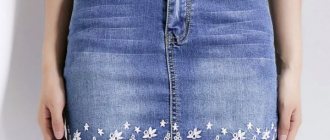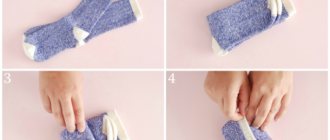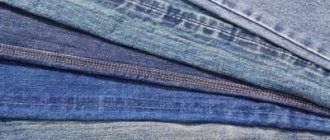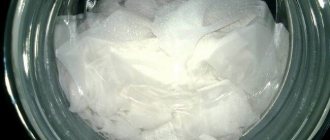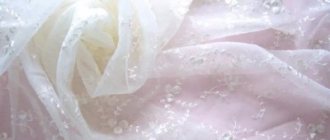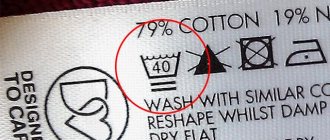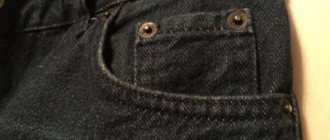Jeans are a basic item in the closet of any modern person, be it a man or a woman. They are comfortable, stylish, and can be worn with almost any top and shoes. But it often happens that your favorite denim trousers stretch, because the fabric from which they are made changes its length and width parameters over time and loses its elasticity. On the one hand, this is a plus. Many people buy pants a size smaller than their own so that the jeans fit exactly to their figure. On the other hand, each wash stretches them again. This problem can affect products from any manufacturer, but much depends on the type of denim fabric.
Jean Jean is one of the cheapest types of fabric for jeans. This is not very high quality cotton, dyed entirely blue. Shrinkage reduces the volume and length of the product. It's better not to buy things made from this material.
Stretch is an elastic fabric, usually used in the manufacture of tight-fitting trousers. They shrink in hot water, but quickly stretch again.
Denim Denim is a very high quality material, painted only on the outside, the reverse side is white. It costs more than others, but also lasts longer. Proper washing only makes the fabric stronger.
Chambray Chambray is a light, thin cotton, 2 times less dense than denim. These are the most short-lived jeans - they quickly lose their shape and wear out. Washing greatly affects shrinkage in all dimensions, including length and width.
If washing has ruined your jeans, there are several shrink methods you can use to return them to their original condition.
Manual method
If you choose to wash by hand, be careful not to burn your hands! This type of shrinkage is best suited for stretch or chambrie trousers. To ensure your jeans fit properly, place them in a basin, or even better, in a bathtub. You need to place them correctly - elongated. You don't have to turn it inside out. Carefully pour hot water - 60-70°C. Leave for half an hour. When the water has cooled, pour boiling water again. Repeat 2-3 times. Then wash as usual with powder in the washing machine. But you will need to rinse them in ice water! You can use the same basin or bath. Add ice to the container and rinse for 10 minutes.
Advice! It is better to dry the product on a flat surface near a heating pipe or in the sun - do not hang jeans on the dryer, they will stretch out again!
How many centimeters maximum can jeans fit?
Jeans is a natural cotton fabric, trousers made of which are so popular all over the world. Denim pants have many advantages: they fit well on the body, tighten it, keep it warm, and look stylish. However, jeans have one main drawback - they tend to wear out, increasing in size, and then the trousers fit loosely, slip down, and hang in bags.
Several household methods can help fix this, such as washing, for example, or even “cooking” jeans. However, you should know that such fraud can only happen with trousers made of natural cotton. You can only pull down your pants one size, so don’t expect to shrink them several times, maximum 1-1.5 cm in diameter.
Washing jeans and shrinking them: tips and tricks
In the washing machine
The best and safest way is machine wash. To make jeans fit 1-2 sizes, you need to select the “Cotton” mode. Set the temperature to high (80-90 degrees) and the highest number of revolutions - 700-800. Add powder and conditioner. It is also better not to dry the item vertically. It is useful to dry wet jeans with an iron; this will promote shrinkage.
Remember! Use this method only on durable fabrics where the cotton content is at least 70%. Otherwise, they will stretch even more in the washing machine. Carefully read the composition and washing and care instructions.
Features of denim fabrics
Jeans began their march around the planet in the middle of the 19th century as an item of clothing for a working man. Both pants and other products, shirts, jackets, were made of dense, coarse cotton, which gave maximum wear resistance and durability. Over time, jeans took over the world, moving into the category of casual wear. The global increase in importance is driven by developments that improve the appearance and functionality of fabrics.
The following types of denim fabrics are distinguished:
Denim. You will have to pay a decent amount for jeans made from real denim. But the price is worth it. They contain exclusively natural, high-quality raw materials. A distinctive feature is the color: blue on the front and white on the back. They are not afraid of high temperatures - washing up to 90 degrees is acceptable.
Jean. If you compare denim and gin, they are the exact opposite of each other. Gin is distinguished by its availability, which, unfortunately, comes with low quality. The coloring is identical for both sides. A special feature is considered to be imaginary shrinkage. Jeans washed in hot water visually shrink in both volume and length. In fact: the fabric will shrink only temporarily. One of the advantages, perhaps, is that along with the size, the softness lost during shrinkage will return.
Stretch. Skinny jeans that embrace every curve of the body with a gentle embrace are sewn from an elastic material called “stretch”. To obtain the existing result, according to the technology, elastic threads are added to coarse fabrics, such as denim. The result is an ideal symbiosis that gives a wonderful aesthetic appearance and a comfortable feeling when worn. The aesthetics of the product are undermined as soon as the jeans begin to stretch, which cannot be avoided with constant, intense wear. Hand washing using hot water and natural drying will correct the situation.
Chambray. Of all denim fabrics, chambry is characterized by its fragility: things made from the fabric wear out quickly and tear easily. After washing in hot water or boiling, they shrink significantly. This is due to the fact that the density of chambrie is much less than that of high-quality denim. But it is precisely this indicator that makes the fabric an ideal material for things for the summer.
The composition of the fabric gives jeans the ability to stretch and shrink. There are effective methods that can reduce the size.
Boiling
To make jeans fit, you can “weld” them. This is probably the most extreme option. There is almost a 100% chance that the color will change and streaks will appear on the fabric. Remember that you can only brew jeans from denim and gin. Other fabrics may deteriorate and will look even worse than before you tried to save them.
Advice! To prevent the color of your jeans from changing too dramatically, turn them inside out before the procedure. The powder should completely dissolve in water.
- Take a saucepan or metal basin.
- Add water and plenty of washing powder.
- Place your pants in the container.
- Place the pan over medium heat and cook for 40 minutes.
- During this time, turn the jeans in the pan so that the color changes evenly on all sides.
- Then remove the item and rinse in cold water.
- Dry horizontally.
- Iron.
After this wash, the jeans should fit exactly 2 sizes.
Do stretch jeans with polyester and elastane shrink after washing?
Jeans can also be made not from 100% cotton fabric, but from a mixture, for example, 70% cotton 30% elastin.
Clothes that are sewn with the addition of elastane (elastane threads) are always distinguished by the fact that they are not able to wrinkle much. It has good water and breathability. However, it does not shrink after washing (by hand or machine) like cotton does.
Elastane (another name for “stretch”) is a fabric that stretches well, and therefore jeans with elastane threads are always durable, fit well on the body and any figure, they are comfortable and comfortable. Stretch jeans can withstand even multiple washes. Like cotton jeans, pants with elastane stretch when worn (give stretch). After washing, the trousers return to their original size (especially good if they are new).
Cotton and stretch jeans: what's the difference?
Air conditioner
To shrink denim pants or certain areas of the product, you can use fabric softener. Add it to warm water - 1:3. Pour the solution into a spray bottle and shake well. Spray it on entire jeans or individual areas. Dry on a horizontal surface. Dry the damp item with an iron.
For those who truly love raw denim
If the desire to buy trousers made from “real” denim cannot be suppressed by any “counterfeits”, then the shrinking procedure will need to be carried out on your own. To ensure that you have enough knowledge and the result is what is expected, you should use a few tips.
1. Required components:
– a large container in which jeans will fit “full-length” (you can use a bathtub, if you don’t mind);
– water heated to a temperature of at least 60 degrees Celsius;
- a weight that will prevent the jeans from floating to the surface (plastic bottles filled with water are perfect).
2. Jeans must be carefully placed at the bottom of the container so that there are no folds or creases on them, and pressed down with a weight. They should soak for at least 4 hours, and there is no need to panic if the water becomes colored. This is absolutely normal. Then the jeans are taken out and hung in such a way that water flows freely down them.
3. If after shrinking you cannot fit into your jeans (they have become tight in the waistband), then you can soak the waistband for another hour and then dry it using special spacers. They will give the width the required size.
Temperature difference
A contrast shower is not only good for your health, but also helps your jeans shrink. To make them sit down and stop stretching, you will need 2 bowls: one for cold water, the other for hot water. Transfer clean jeans from one container to another: first into cold water for a few minutes, then into boiling water for a couple of minutes. Repeat the procedure 5-7 times, then dry the product on a horizontal surface.
Advice! If you have time, you can leave the jeans in ice water all night, and in the morning rinse them in boiling water and dry them.
Failure of all attempts: what to do?
Making things smaller, and only in the necessary places, is not just a difficult task, but often impossible. Synthetic and mixed fabrics are the most difficult to shrink.
It is almost impossible to reduce items with embroidery and other decor, elegant clothes, as well as those that cannot be subjected to wet processing without damaging the item.
If a product made of cotton, linen or wool does not shrink properly, the processing process can be repeated. But in cases where the methods of influence are ineffective, you will have to either say goodbye to the thing or give it away for rework.
Drying rules
To prevent jeans from stretching, they need to be dried properly. That's right, that means fast. The fact is that regular drying, which takes from 5 to 10 hours, only contributes to the stretching of the fabric - the fibers have time to become straight and recover. This does not happen during fast drying. To make your jeans dry quickly:
- hang them next to the radiator or stove, or in the sun;
- put a fabric under your jeans that will absorb excess moisture;
- Use a tumble dryer if possible.
Attention! Remember that each method that helps to shrink jeans changes not only the width of the waist and hips, but also the length of the legs.
When purchasing new pants, always try them on well.
If the material stretches a lot, it is better to take a jeans size smaller. Choose quality denim or gin. Be sure to follow the washing rules. You can also stretch your jeans after washing if they have shrunk too much at home using improvised methods.
How to sew a finishing stitch
To make new stitches seem professionally made, you need to very carefully remove old threads and select the shade of new ones. Before joining the parts, you will need to steam and iron the jeans. It will be difficult to sew a finishing stitch like in a store. Many people may be faced with the fact that the machine does not take the thickness of the thread on jeans, makes gaps or sets the wrong pitch.
To complete the finishing as efficiently as possible, you will need to follow some tricks:
- The top thread should be decorative, the bottom thread should be regular. The tension step needs to be loosened.
- The needle is placed a little lower, but not all the way.
- Foot with guide.
Most often it happens that the needle cannot pierce the thick layer of fabric on the jeans, so it makes gaps. To prevent this from happening, you need to use a few tricks. The first thing is to iron the edges of the jeans well or beat them with a hammer to soften them. Usually after these steps you get a beautiful decorative seam.
See also
How to quickly starch a hat with your own hands at home
Along the back seam
It is difficult to remove extra centimeters in the area of the fifth point. The belt loop and label are removed along the back seam. It's easy to flog her. Next, you will need to put on the jeans in this condition to see exactly where to remove the fabric. The excess is pinned and basted with thread. The fitting takes place again, and only then is it worth going through the machine. The front part of the jeans is sewn on, then the belt, label and belt loop are sewn on.
At the waist, belt
If the jeans are large in the waist and waist, then the seams will have to be cut in large quantities. In order to connect and baste all the parts correctly, you need to use the tips given above.
How to narrow flares in legs, straight to narrow
Sewing flares on jeans means giving them new life. Straight or even narrow models are in fashion now, so it’s worth working on old options to reshape them.
It is necessary to stitch along the inside seam, because decorative stitching often runs on the outside.
It’s worth turning the jeans inside out, chalking out the progress of the work, undoing the old stitching, and ironing the edges. Baste and try on. If the pattern fits, you can cut off the rest of the fabric, stitch the edges with thread, and go over it with an overlocker. Next, iron the edges so that the jeans look perfect. Straight jeans can be turned into skinny ones in a similar way, just the depth of the cut will be less.
Sewing jeans
If you couldn’t shrink your pants, and washing has completely ruined them, you have only one option left - sew in your pants. You can do it yourself or take it to a studio.
Sides
Usually trousers are sewn in from the sides. First you need to measure your waist circumference, choose an elastic band, it should be less in length than the volume. Sew a wide elastic band from the inside out into the waistband of your jeans. Try it on. If everything is in order, sew the belt, passing the elastic inside.
Next, proceed to the sides. “Mark” unnecessary centimeters with chalk. Open up the waistband and pockets. Make a preliminary seam and try it on. If everything suits you, sew the details of the clothing.
Hips
The most common problem is that it is in this part of the jeans that the sizes usually do not suit you. The hardest part here is leaving a nice seam and finish. To “reduce” your hips, start from the top, then proceed to the waist and sides. Use threads that are close in color to the shade of your trousers.
How to suture
When the jeans are too big and the fabric itself does not shrink, then the surest way to get rid of extra centimeters in the waist and hips is to sew them up.
In a workshop
Yes, this is the most professional advice. The master will take the correct measurements, cut where necessary, and sew the item so that it will not differ from the factory one. The only thing is that the cost will not be the lowest. If the jeans themselves are not expensive, or you simply don’t want to pay someone for a simple job, you can try not going to a workshop, but sewing them yourself.
See also
How to quickly iron tulle after washing and rules for choosing temperature
How to alter it yourself
This is a labor-intensive process that requires certain skills, time and equipment.
What you will need for work:
- Sewing machine.
- Scissors.
- Tailor's pins.
- Threads.
- Overlock.
- Steamer.
- Chalk, pencil or piece of soap.
- Iron.
If you decide to alter your jeans yourself, you will need the items and tips listed above. First of all, you need to rip out the seams in problem areas. This can be done with simple scissors or use a steamer. This is a special tool with a sharp end that easily penetrates the stitching and removes threads. When everything is done, you need to remove the old threads and iron the parts with an iron. Next you need to take measurements. Remove extra centimeters on the parts. To do this, draw new markings with chalk or soap.
Next, you will have to sketch out a new version of the model. Do a fitting. If the jeans fit well, you can begin to secure the seams.
To prevent the cut edges from fraying, you need to process them with an overlocker .
It is worth telling that the sewing options are different. There are different methods at work in the waist, hips or length.
We wash the silk so that it shrinks
Natural silk is an elite and expensive fabric. Clothes, bedding and interior items are made from it. For many silk products, manufacturers recommend hand washing at 30 C°. For washing in a machine, use the “Delicate Wash” and “Silk” programs. Clothes are dried away from sunlight to maintain the appearance and shape of the clothing. In order for silk clothes to shrink, wash them at 40 C° and spin 400 rpm. Dry in the sun. Be prepared for the fact that colored silk may fade. If you are afraid of ruining an expensive silk product by washing, contact a studio.
If your favorite clothes have stretched out after washing, use the recommendations presented in the article. Share your new proven methods for shrinking fabric in the comments to the article.
Machine washable
You can narrow your jeans quickly and without problems, and at the same time wash them, in an automatic washing machine.
If you don’t know what to do with stretched out pants and other methods have proven useless, use this method.
The following actions will help to significantly reduce the volume:
- Place the item in the drum. Pour liquid detergent into the powder compartment. If your pants are shedding, you cannot add powder during this procedure. The pants will lose color.
- Turn on the device, setting the temperature to 90 degrees, washing to intensive, spin to maximum speed.
- The effect is secured with a contrast rinse.
This method of making jeans narrower is suitable for trousers made from natural denim or high-density cotton fabric.
After such a procedure, the material should shrink to the desired size, perfectly fitting the figure and emphasizing its advantages.

